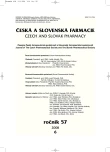The effect of lipophilic carrier concentration on hydrophilic-lipophilic matrix systems characteristics
Authors:
K. Dvořáčková; M. Rabišková; R. Masteiková; L. Okáčová
Authors‘ workplace:
Veterinární a farmaceutická univerzita Brno, Farmaceutická fakulta, Ústav technologie léků
Published in:
Čes. slov. Farm., 2008; 57, 269-274
Category:
Original Articles
Overview
The present experimental paper aimed to examine the effect of lipophilic carrier concentration on diclofenac sodium prolonged release from hydrophilic-lipophilic matrix tablets with respect to the optimization of its dissolution profile in vitro. The lipophilic carrier was cetyl alcohol contemporaneously acting as the melting binder in thermoplastic granulation, povidone was used as the gel-forming agent, sucrose or lactose were fillers. The obtained results indicated that cetyl alcohol concentration influenced both characteristics of the granulates and the tablets. The dissolution profile of sucrose samples was affected statistically significantly by cetyl alcohol concentration, in the case of lactose samples only when a higher cetyl alcohol concentration was used. The increasing concentration of cetyl alcohol led to a slower drug release. From the obtained results it is apparent that sucrose samples released drug faster in comparison with the lactose monohydrate ones, especially when a lower lipid carrier concentration was used.
Key words:
matrix tablets – controlled release – cetyl alcohol – melt granulation
Sources
1. Rabišková, M.: Remedia, 2007; 17, 188-192.
2. Raymond, C., et al.: Handbook of Pharmaceutical Excipients. 5. ed. London: The Pharmaceutical Press, 2006, s. 651.
3. Rabišková, M., Komárek, P. et al.: Technologie léků. 3. přeprac. a dopl. vyd. Praha: Galén, 2006, s. 399.
4. Dvořáčková, K. et al.: Čes. slov. Farm., 2007; 56, 129–134.
5. Bozi, D. Z., Vreer, F., Kozjek, F.: Eur. J. Pharm. Sci., 1997; 5, 163–169.
6. Gil, E. C. et al.: Int. J. Pharm., 2006; 317, 32–39.
7. Gren, T., Nyströc, C.: Int. J. Pharm., 1999; 184, 7–19.
8. Maheshwari, M. et al.: Int. J. Pharm., 2003; 261, 57–67.
9. Paradkar, A. et al.: AAPS Pharm. Sci. Tech., 2003; 4(4) Art 65.
10. Devaraj, G. N. et al.: J Colloid Interface Sci., 2002; 251, 360–365.
11. Savickas A., Bernatonienė J.: Medicina (Kaunas), 2005; 41(3), 226.
12. Avachnnt, A., Kotwal, V.: AAPS PharmSciTech, 2007, 8, Art. 88 (http://www.aapspharmscitech.org).
13. Chopra, S., Patil, G. V., Motwani, S. K.: Eur. J. Pharm. Biopharm., 2007, 66, 73–82.
14. Singh, B., Chakkal, S. K., Ahuja, N.: AAPS Pharm. Sci. Tech., 2006; 7 (1) Art. 3 (http://www.aapspharmscitech. org).
15. Pereira de Souza, T. et al.: AAPS Pharm. Sci. Tech, 2007, 8(2), Art. 34 (www.aapspharmscitech.org).
16. Saravanan, M. et al.: Biol. Pharm. Bull., 2002; 25, 541–545.
17. Rabišková, M. et al.: Čes. slov. Farm., 2003; 52, 211–217.
Labels
Pharmacy Clinical pharmacologyArticle was published in
Czech and Slovak Pharmacy

2008 Issue 6
Most read in this issue
- Possible effects on the liberation of alaptid from dermal semisolid preparations
- Studies of local anesthetics Part 185: Thermodynamic parameters of heptacainium chloride in the solution of NaBr
- Optimization of the extraction method for the determination of methadone and its metabolite EDDP in urine by gas chromatography
- The effect of lipophilic carrier concentration on hydrophilic-lipophilic matrix systems characteristics
